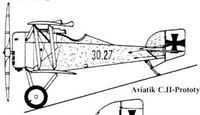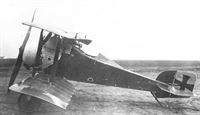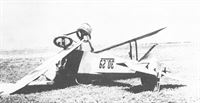W.Green, G.Swanborough The Complete Book of Fighters
AVIATIK (BERG) 30.27 & 29 Austria-Hungary
Whereas all previous single-seat fighters designed by von Berg had utilised Austro-Daimler inline engines, the Aviatik 30.27 and the similar 30.29, which appeared early in 1918, were powered by the 160 hp Steyr Le Rhone 11-cylinder rotary. Of wooden construction with plywood fuselage skinning, apart from the forward section which was covered by light metal panels, and fabric-covered wings, the Aviatik 30.27 and 30.29 each carried the standard twin-Schwarzlose gun armament, and were initially flown with two-bladed propellers. Subsequently, the original engine cowling (which left the lowest three cylinders exposed) was replaced by a full ring cowling, and the four-bladed Jaray propeller was adopted. Both participated in the July 1918 D-Contest, 30.29 crashing when the upper wing leading-edge collapsed as its pilot initiated a loop. The following details apply to the 30.27 in its final form.
Max speed, 115 mph (185 km/h) at 2,625 ft (800 m).
Time to 3,280 ft (1000 m), 1.42 min, to 6,560 ft (2 000 m), 3.75 min.
Empty weight, 851 lb (386 kg).
Loaded weight, 1,336 lb (606 kg).
Span, 22 ft 4 1/2 in (6,82 m).
Length, 16 ft 4 3/4 in (5,00 m).
Height, 8 ft 6 3/4 in (2,61 m).
P.Grosz, G.Haddow, P.Shiemer Austro-Hungarian Army Aircraft of World War One
Aviatik 30.27 and 30.29
The LFT aircraft specifications for 1918 listed a Type 5 fighter, an ultra-light interceptor powered by a 150 hp rotary engine. This took into account that, as of May 1917, rotary engine production had begun at the Oesterreichische Waffenfabrik AG, Steyr in anticipation of receiving sufficient supplies of Voltol (castor oil substitute) from Germany. A Steyr rotary engine based on the 150 hp Le Rhone was submitted for duration tests in November 1917. It is not generally known that Steyr delivered 35 out of 150 ordered Le Rhone (St) engines through September 1918 and the rest were nearing completion when the war ended.
Only Aviatik's rotary-engined fighters were flight tested, although several manufacturers had similar fighters under development at the war's end. The drawings for the first Aviatik prototype, 30.27, were completed in January 1918. The prototype arrived at Aspern for flight tests in March. Preliminary trials demonstrated severe wing twist when the ailerons were actuated. The aircraft was re-built with a larger wingspan, longer fuselage and a fully-cowled engine. During trials in May 1918, the modified 30.27 reached a maximum speed of 200 km/h (124 mph), but the climb rate did not meet the LFT criteria.
The Aviatik 30.29 was similar in all respects to the 30.27. Both aircraft participated in the July 1918 Fighter Evaluation at Aspern. Neither received praise or condemnation and any hope of a favorable critique disappeared when the upper wing of 30.29 failed in flight.
The manufacturer's drawings, dated March 1918, refer to a version, based on the 30.29 and designated Aviatik D.III, for which series production was contemplated. But Voltol production, sufficient to meet German but not export requirements, thwarted LFT plans to put a rotary-engined interceptor into service. Consequently, interceptor development was accorded low priority. Because "no aircraft were ready," in September 1918 Flars recommended sending the completed Steyr engines to Germany in return for Oberursel rotary engines at a later date.
Aviatik 30.27 Specifications (Open Cowl)
Engine: 150 hp Le Rhone (St)
Wing: Span Upper 6.60 m (21.65 ft)
Span Lower 6.60 m (21.65 ft)
General: Track 1.80m (5.91 ft)
Empty Weight 350 kg (772 lb)
Loaded Weight 600 kg (1323 lb)
Maximum Speed: 200 km/hr (124 mph)
Climb: 1000m (3,281 ft) in 1 min 24 sec
2000m (6,562 ft) in 3 min 6 sec
3000m (9,843 ft) in 7 min 58 sec
4000m (13,124 ft) in 15 min 15 sec
5000m (16,405 ft) in 22 min 32 sec
Aviatik 30.27 Specifications (Closed Cowl)
Engine: 150 hp Le Rhone (St)
Wing: Span Upper 6.82 m (22.38 ft)
Span Lower 6.60 m (21.65 ft)
Chord Upper 1.40 m (4.59 ft)
Chord Lower 1.25 m (4.10 ft)
Maximum Speed: 190 km/hr (118 mph)
Climb: 1000m (3,281 ft) in 2 min 11 sec
2000m (6,562 ft) in 5 min 20 sec
3000m (9,843 ft) in 9 min 18 sec
4000m (13,124 ft) in 18 min 12 sec
Aviatik 30.31 and 30.32
The Aviatik 30.31 and 30.32 prototypes were similar to the final version of the 30.27 fighter. When it became evident that lack of lubricating oil would prevent the operational use of rotary engines, development work was interrupted and both aircraft were reported stored in "good condition" in the Aviatik hangars in July 1918. At war's end, they were pro-forma accepted to enable Aviatik to receive payment for the aircraft.
E.Hauke, W.Schroeder, B.Totschinger Die Flugzeuge der k.u.k. Luftfahrtruppe und Seeflieger 1914-1918
30. Flugzeuge der Österreichischen Aviatik-Werke Wien, Stadlau
30.27 Berg D Leichtbaueinsitzer St 160
30.29 Berg D Leichtbaueinsitzer St 160
30.31 Berg D Prototyp für D.III (Leichtbaueinsitzer) St 160
30.32 Berg D Prototyp für D.III (Leichtbaueinsitzer) St 160
 |
E.Hauke, W.Schroeder, B.Totschinger - Die Flugzeuge der k.u.k. Luftfahrtruppe und Seeflieger 1914-1918
|
| Aviatik C.II-Prototyp
|
 |
P.Grosz, G.Haddow, P.Shiemer - Austro-Hungarian Army Aircraft of World War One /Flying Machines/
|
| Aviatik 30.27 (first version). Among test pilots, the aircraft was nicknamed Schnucki (slang for a cuddly girl friend). It was armed with twin Schwarzlose machine guns. The aileron wash-out is quite pronounced.
|
 |
W.Green, G.Swanborough - The Complete Book of Fighters
|
The Aviatik (Berg) 30.27 appeared early in 1918 with a Steyr Le Rhone rotary engine.
The Aviatik 30.27 which, together with the similar 30.29, participated in the D-type contest of July 1918
|
 |
P.Grosz, G.Haddow, P.Shiemer - Austro-Hungarian Army Aircraft of World War One /Flying Machines/
|
The Aviatik 30.27 (first version) was designed to meet the 1918 interceptor specification. The loaded weight was a mere 600 kg (1323 lb).
Aviatik 30.27, Prototyp für Berg D.III, Leichtbaueinsitzer
Aviatik 30.27, прототип Berg D.III, легкий одноместный истребитель
|
 |
P.Grosz, G.Haddow, P.Shiemer - Austro-Hungarian Army Aircraft of World War One /Flying Machines/
|
Aviatik 30.27 (second version) fitted with strengthened wings, elongated fuselage, and fully-cowled engine. The thin, four-bladed propeller was an attempt to maximize thrust. Although a top speed of 200 km/h (124 mph) was recorded, the rate of climb was deemed insufficient for an interceptor.
Aviatik 30.27, nach Rumpfumbau, kleineres Seitenruder und Anbau eines vierflügeligen Jaraypropcllers für bessere Steigleistung
Aviatik 30.27, после переделки фюзеляжа, уменьшенного руля направления и установки четырехлопастного пропеллера Jaray для лучшей скороподъемности
|
 |
P.Grosz, G.Haddow, P.Shiemer - Austro-Hungarian Army Aircraft of World War One /Flying Machines/
|
| Aviatik 30.29. On 10 July 1918 the upper leading edge folded back just as Hauptmann Karl Nikitsch was entering a loop during the Fighter Evaluation. He was fortunate to survive the crash from 2000 meters (6562 ft) without serious injury!
|
 |
W.Green, G.Swanborough - The Complete Book of Fighters
|
|
|
 |
P.Grosz, G.Haddow, P.Shiemer - Austro-Hungarian Army Aircraft of World War One /Flying Machines/
|
| Aviatik 30.27 (first version)
|









